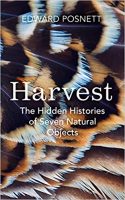Harvest: The Hidden Histories of Seven Natural Objects
by Edward Posnett
Bodley Head (£16.99)
 The Telegraph style guide forbids the spelling-out of “foul language”, so I can only go so far, and tell you that Harvest is a book full of fascinating s***. It tells how, for example, in the middle of the 19th century, there was a fortune to be made selling bird excrement, and how, at the start of the 21st, some of us were persuaded that coffee was at its best when made with beans from the scat of a tree-climbing mammal.
The Telegraph style guide forbids the spelling-out of “foul language”, so I can only go so far, and tell you that Harvest is a book full of fascinating s***. It tells how, for example, in the middle of the 19th century, there was a fortune to be made selling bird excrement, and how, at the start of the 21st, some of us were persuaded that coffee was at its best when made with beans from the scat of a tree-climbing mammal.
Bird guano (once widely used as a fertiliser) and civet coffee are two of seven naturally occurring wonders collected by humans that Edward Posnett follows from harvest to market. The others are eiderdown; the edible bird’s nest; sea silk, the anchoring “beard” of a giant mussel; vicuña fibre, sheared in the wild from a South American relative of the llama; and tagua, the ivory-like seed of a palm tree, which has been turned into buttons, toys and carvings.
The book had its beginning in a prize-winning essay in which Posnett, who after university had worked in financial investigations in the City of London, explored the relationship between Icelanders and the eider duck. For centuries people in the remote Westfjords region of Iceland have offered shelter to nesting eiders, protected them from predators and, once the chicks have hatched, collected their reward: the down the mother bird draws from her breast to make the nest. In medieval times that down was accepted as payment by tax collectors; today it fills jackets that cost more than £6,000 apiece.
We live, Posnett notes, in a world “dominated by a species that is gradually driving the wild to destruction”. The relationship between Icelanders and eiders seemed to offer a rare example of equality rather than exploitation: “if either party failed to abide by their contract, the other… could simply walk or waddle away”. That prompted him to begin looking into small-scale harvests that held out the promise of a similar balance, and to travel in Europe, Asia and South America to see how they worked.
He was, perhaps, bound to be let down. After all, even the eider arrangement has its dark side: to ensure the birds aren’t bothered, their human minders kill Arctic foxes. They may also have been partly responsible for the near-extinction in the 1960s of the white-tailed eagle. If the writer is often disillusioned, though, the reader is endlessly diverted.
In Sarawak, Malaysia, Posnett watches as a lean, muscled climber negotiates a network of bamboo poles and wooden ladders built high inside a limestone cave (“the work of a carpenter unhinged”) to scrape off the nests that black-nest swiftlets have made with saliva and feathers. For this man, caves are sacred places, named after the spirits who led him to their entrances. In Java, Indonesia, Posnett is shown a bird house specially built to draw the white-nest swiftlet, complete with speakers playing birdsong, an enterprise its builder describes as “a small bank”. Wherever the author goes, whatever tradition and trade he explores, there’s a constant: the harvesters receive only a tiny cut of the final price of their produce.
In Indonesia, he finds that, while one coffee dealer goes out of his way to collect civet scat without disturbing its producer, others are less scrupulous. They farm civets, cut their fingernails to stop them climbing and keep them in cages.
In Sardinia, he meets a woman who styles herself the “maestro” of byssus, or sea silk. She gives away what she weaves, saying that sea silk “cannot be bought or sold and does not submit to the laws of the market”, but she is monopolistic in her own way: she insists that her account of its history be the only one heard.
Posnett moved from London to Philadelphia halfway through the writing, which may help explain Americanisms such as “met with” instead of “met” and “fit” instead of “fitted”. Then there’s eiderdown, which is the subject of his first chapter. Many (if not most) people, I’d imagine, use “eiderdown” casually when talking of a duvet or any upper layer of bedclothes. It seems bizarre, then, to have the author say as late as his final chapter that he was “disconcerted” to learn of this usage.
Editing oddities aside, Harvest is a rich and absorbing exploration of places where a singular culture meets global capitalism. And a reminder, too, that where there’s muck there’s brass. MK
This review appeared in print in The Daily Telegraph on October 26, 2019
